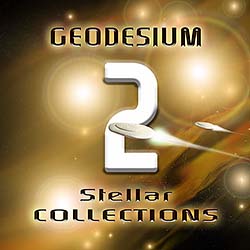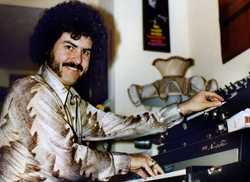Stellar Collections 2
Travel farther through space and further back in time!
Devotees of space music have a new collection of planetarium soundtrack works by Mark C. Petersen to savor, in this follow-up album to the 2001 release Stellar Collections.
In Stellar Collections 2, Mark has gathered 30 space music compositions into various "suites" featuring his planetarium soundtrack work from '70s, '80s and '90s. The planetarium is the major medium he has composed for since 1975, and according to Petersen, it inspires much of his work. "I create music as a major part of the audio-visual experience of the modern planetarium show. It complements and enhances the immersive environment we encounter under the dome."
Geodesium (pronounced Gee-oh-DEE-zee-um) is a blending of the words "geodesic dome" and "planetarium", and it's become the nom-de-plume for Mark's space music. As with the previous albums, much of the music comes from the rarefied domain of planetarium programs, underlying and interacting with narratives. Removed from this context in album form, the music comes to the forefront, allowing the listener to appreciate its rhythms and graceful melodies on their own.
While avid Geodesium fans may recognize some familiar themes among the works comprising this retrospective, all 30 selections are recordings previously unreleased to the general public; none have been heard outside of the planetarium show context for which they were created. The compositions on this CD will give listeners a chance to explore the mysteries of space with music that works on many diverse and cosmic scales.
Mark offers some reflections on the album tracks:
We're reaching back to some of the early days on this album (from even before the release of the first GEODESIUM album), and spanning more than two decades worth of the musical and technological development that followed.
Light Years From Andromeda was the first planetarium show Loch Ness Productions produced for itself, back in 1980. It's been re-created two more times thereafter; in 1997, I completely remade the soundtrack, and we added all new visual material. In 2009, we made the show into its fulldome version, though the soundtrack stayed the same. The early version used only the Oberheim TVS-1 synthesizer and Rhodes electric piano (what you see in the photo); the 1997 version had a full panoply of instrumentation. The Light Years Collection is a medley from the 1997 soundtrack (another medley appeared as The Andromeda Collection on the first Stellar Collections album); Diffractions, Memories Of Mimas, and Footsteps On Phobos are from the early version.
Eternal Outpost was actually the opening music for the Fiske show Voice Of The Martian Wind. Fiske had acquired an 8-channel tape deck for the studio; I filled each channel with a long tape-loop filtered Mellotron chord, then played the mixer faders to change from chord to chord, while adding HTS from the Synthi.
Approaching The Giant and The Lakes Of Titan were also Fiske-era pieces, though not used in any Fiske show. The Lakes Of Titan went into our 1981 show, Saturn: Before Voyager... and After.
In 1979, I used the Fiske studio for the last time, to work on my first non-Fiske planetarium soundtrack, The Martian Stargazers for Gates Planetarium. Martian Eternity is from that show.
I used the opening and closing music from the 1986 McDonnell Planetarium show Lightwaves as bookends here — to begin The Exploration Collection and end The Event Horizon Collection. (See Infinite Light for more about Lightwaves music.)
1988 brought a couple of great soundtracks; Alien Whispers for St. Louis, and Loch Ness Productions' own The Mars Show. Music from these first appeared on Fourth Universe; Are We Alone, An Elusive Signal, and Light Flight are from that same time.
Exovolcanoes and Tectonic Shift were created four years later for the Loch Ness Productions show MAGELLAN: Report From Venus. A hellish place, Venus, with its carbon dioxide atmosphere and sulfuric acid rains, so it gets growly minor music to accompany.
Time Dilation was also from 1992, for a show about Aztec skywatchers, although there is not much Mexican flavor in this track. It's spacey enough to include here in The Event Horizon Collection, the album's longest montage, which blends music from all three of the analog decades. (See A Gentle Rain Of Starlight and Stella Novus for examples of more recent digital-era recordings.)




